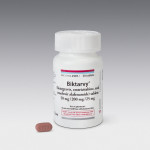Long-term follow-up data from a study indicate higher response rates with Norvir (ritonavir)-boosted Reyataz (atazanavir) compared with Kaletra (lopinavir/ritonavir) in HIV-positive patients starting therapy for the first time. The 96-week study results, which also suggest potential gastrointestinal and lipid side effect advantages in those using Reyataz/Norvir, were reported October 26 at the 2008 joint meeting of the Interscience Conference on Antimicrobial Agents and Chemotherapy (ICAAC) and the Infectious Disease Society of America (IDSA).
The U.S. Department of Health and Human Services lists Norvir-boosted Reyataz as a “preferred” protease inhibitor (PI) option for individuals starting their first antiretroviral (ARV) drug regimen.
Resuls from the 96-week international CASTLE study were reported at ICAAC/IDSA by Jean-Michel Molina, MD, of the Hospital St. Louis in Paris. First-time treatment takers were randomized to use either once-daily Reyataz (300 mg) plus Norvir (100 mg) or twice-daily Kaletra (400 mg/100 mg), with both groups also using a standard dose of Truvada (tenofovir plus emtricitabine).
Upon entering the study, the 883 HIV-positive patients enrolled had average viral loads of 95,500 copies and CD4 counts of 205.
After 96 weeks, according to a strict (intent-to-treat) study analysis, 70 percent of those in the Reyataz/Norvir group had viral loads below 50 copies; in the Kaletra group, about 63 percent had viral loads below 50 copies.
Rates of treatment discontinuation were higher in the Kaletra group compared with the Reyataz/Norvir group—21 percent versus 16 percent, respectively. As there was similar virologic effectiveness, but higher rates of discontinuations among patients receiving Kaletra, Dr. Molina’s group concluded that Norvir-boosted Reyataz had a higher response rate.
Norvir-boosted Reyataz and Kaletra appeared to work equally well, regardless of disease severity upon entering the study. In Reyataz/Norvir takers, about 74 percent of patients who began treatment with viral loads above 100,000 copies had undetectable viral loads after 96 weeks. In those on Reyataz/Norvir who started treatment with viral loads below 100,000 copies, 75 percent had undetectable viral loads. In the Kaletra group, 66 percent of patients with pre-treatment viral loads above 100,000 copies and 70 percent of patients with pre-treatment viral loads below 100,000 copies had viral loads below 50 copies after 96 weeks.
CD4 count improvements were roughly similar in both groups. There was a 268 CD4 cell gain in the Reyataz/Norvir group, compared with a 290 cell gain in the Kaletra group.
Of the 106 patients who entered the study with fewer than 50 CD4 cells, more patients in the Reyataz/Norvir group (78 percent), compared with those in the Kaletra group (58 percent), were able to keep their viral load undetectable for 96 weeks.
As for side effects, some time was spent reviewing changes in cholesterol and triglycerides, as these aren’t significantly affected by Reyataz and may be only moderately increased when a Norvir booster is used.
In CASTLE, total cholesterol levels increased by 13 percent in the Reyataz/Norvir group, compared with a 25 percent increase in the Kaletra group. Triglyceride increases of 13 percent and 50 percent, respectively, we also reported. These differences were statistically significant, meaning that they are too large to have occurred by chance.
Moderate increases in both “bad” LDL cholesterol and “good” HDL cholesterol were seen in both groups of patients, with no statistically significant differences between the two.
The authors also noted a lower incidence of diarrhea (2 percent versus 11 percent) and nausea (4 percent versus 8 percent) in the Reyataz/Norvir group, compared with the Kaletra group. It is important to note, however, that patients randomized to the Kaletra group began the study by taking the older, less-palatable capsule version of the drug; a better-tolerated tablet version is now used.
The 96-week conclusion offered by the study authors is that Norvir-boosted Reyataz “demonstrated durable antiviral activity and safety. This regimen is an appropriate therapeutic option for antiretroviral-naïve HIV-infected patients.”
Advertisement
Advertisement
Advertisement






Comments
Comments